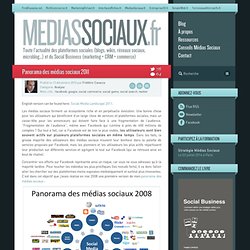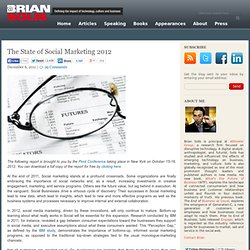

Plaidoyer pour le déclenchement de la « guerre » sur les réseaux sociaux. Tout d’abord, oui le titre est un peu provocateur.

Je vais pouvoir vérifier l’impact de cette approche sur les visites du Blog voire les commentaires émis ;) La genèse de cet article tient au fait qu’aujourd’hui les entreprises présentes sur les réseaux sociaux commencent à intégrer de façon verticale la gestion des demandes des clients & prospects. Avec l’animation des comptes officiels Twitter, des fanpages Facebook, les entreprises ouvrent à leurs clients un nouveau canal de relation client à distance après avoir utilisé ces nouveaux vecteurs comme des solutions pour faire la promotion de leurs offres, la communication institutionnelle, l’engagement du dialogue, le traitement des réclamations. A voir donc également le succès des solutions (dîtes) SCRM qui gèrent la notion de verticalité (une pensée d’ailleurs à DIMELO), le train de la social relation client est en marche. 1. Celles liées à la vie privée sont à mon sens à prendre en compte. 2.
Quels pré-requis ? Quelle organisation ? 8 Ways To Avoid Social Media Culture Clash - The BrainYard. Social CRM : le nouvel eldorado des marques ? - Disko. Social_networks_adoption_lifecycle.png (1275×711)
STATS. Vers une 3ème phase de maturité des marques sur les médias sociaux. Cette semaine s’est tenue la très instructive conférence M2C à Paris (cf. les comptes-rendus des jour 1 et jour 2).

Le thème de cette conférence était “Social Media is Dead“. Derrière cette provocation se cache une réalité : les médias sociaux ne sont plus de territoire d’expression quasi-vierge que les marques peuvent s’approprier. Pratiquement toutes les marques sont ou vont très rapidement être présentes sur les médias sociaux pour assurer la promotion de leurs produits ou gérer leur réputation.
De ce fait, la compétition pour l’attention et les “like” des membres y est aussi féroce que pour les clics sur les pages de résultats de Google. Forcément, ça devait bien arriver un jour. Phase 1 : Expérimentations Les médias sociaux sont nés avec l’avènement des blogs, réseaux sociaux et plateformes de partage (MySpace, YouTube, Facebook…), c’est à dire il y a plus de 5 ans.
Gt; Panorama des médias sociaux 2011. English version can be found here: Social Media Landscape 2011.

Les médias sociaux forment un écosystème riche et en perpétuelle évolution. Une bonne chose pour les utilisateurs qui bénéficient d’un large choix de services et plateformes sociales, mais un casse-tête pour les annonceurs qui doivent faire face à une fragmentation de l’audience. “Fragmentation de l’audience“, même avec Facebook qui culmine à près de 600 millions de comptes ? Oui tout à fait, car si Facebook est de loin le plus visible, les utilisateurs sont bien souvent actifs sur plusieurs plateformes sociales en même temps. Dans les faits, la grosse majorité des utilisateurs des médias sociaux trouvent leur bonheur dans la palette de services proposés par Facebook, mais les pionniers et les utilisateurs les plus actifs répartissent leur production sur différents services et agrègent le tout sur Facebook (qui se retrouve ainsi en bout de chaîne). Voilà qui nous fait une sacrée collection !
Social CRM: une définition par Altimeter et quelques considérations. Altimètre a récemment créé et partagé ce rapport écrit par Ray Wang et Jérémie Owyang, appelé Social CRM: Les nouvelles Règles de Gestion de la Relation.

Le framework est conçue pour donner une définition à ce que nous entendons par Social CRM, à la fois pour repondre aux besoins de certains types d’entreprises, dans les stratégies de conversation et des relations avec les consommateurs grâce aux média sociaux. Le Social CRM ne remplace pas les outils existants de gestion des relations client, mais travail à ses côtés, ce qui permet d’exploiter l’ interaction possible que avec médias sociaux. Nous passons de la période de transition (end-to-end CRM), à celle de l’ interaction. Les consommateurs ne croient plus aux organisations, en conséquence les espace de conversations peer-to-peer sont de plus en plus utilisé pour poser des questions ou chercher des réponses, et cela se passe sur Twitter, sur les forums, blogs, etc. Gary's Social Media Count. Click for App Store Page Original Counter and Post from 24 Sep 2009!
June 2013 ‘Social’ Update (mobile, games & heritage to come) The Social Media Effect. Unleashing the value of Social CRM: Where to find the biggest return « Brian Vellmure's CRM Strategies Blog. Actimag Hors série N°3 // Avril 2011. Le Social CRM : enjeux et perspectives de la relation client 2.0. Avec l’explosion d’Internet, un nouvel espace d’expression et de partage s’est ouvert aux consommateurs.

Sur plus de 1.8 milliards d’internautes dans le monde, 39% s’accordent à dire que « dans un monde connecté, je peux mieux exprimer mes sentiments ». De nombreuses études ont en effet été consacrées à ce sujet et toutes convergent vers le même constat : Les internautes n’ont jamais été aussi actifs et enclins à échanger librement sur les produits et services qu’ils utilisent.
Du coup, les interactions entre une marque et ses clients se sont multipliées. Les maîtriser devient de plus en plus nécessaire. Voici le point de vue de Philippe Pestanes, Associé responsable du pôle TIMES (Télécommunication, Information, Média, Entertainment et Sport) de Kurt Salmon. Face à ces nouveaux profils de consommateurs et à cette évolution des usages, une nouvelle forme de relation client (plus en phase avec les supports Web 2.0) s’est développée dans les groupes. Why Your Company Needs to Embrace Social CRM. Maria Ogneva is the Director of Social Media at Attensity, a social media engagement and voice-of-customer platform that helps the social enterprise serve and collaborate with the social customer.

You can follow her on Twitter at @themaria or @attensity360, or find her musings on her personal blog and her company's blog. If you have been tracking conversations around social media for business, you have undoubtedly come across people talking about Social CRM. If you are anything like me, the first time you heard it, you probably rolled your eyes and said, “Ugh, another social media buzzword!” The State of Social Marketing 2011 – 2012. InShare1,121 The following report is brought to you by the Pivot Conference taking place in New York on October 15-16, 2012.

You can download a full copy of the report for free by clicking here. At the end of 2011, Social marketing stands at a profound crossroads. Some organizations are finally embracing the importance of social networks and, as a result, increasing investments in creative engagement, marketing, and service programs. Others see the future value, but lag behind in execution. In 2012, social media marketing, driven by these innovations, will only continue to mature. The Ultimate Social CRM Resource Guide – 1st Edition « Brian Vellmure's CRM Strategies Blog. The Evolution of the Social CRM Process. The Conversation Prism v2.0.